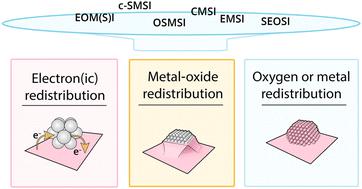当前位置:
X-MOL 学术
›
Chem. Soc. Rev.
›
论文详情
Our official English website, www.x-mol.net, welcomes your
feedback! (Note: you will need to create a separate account there.)
Metal–support interactions in metal oxide-supported atomic, cluster, and nanoparticle catalysis
Chemical Society Reviews ( IF 40.4 ) Pub Date : 2024-10-02 , DOI: 10.1039/d4cs00527a Denis Leybo, Ubong J. Etim, Matteo Monai, Simon R. Bare, Ziyi Zhong, Charlotte Vogt
Chemical Society Reviews ( IF 40.4 ) Pub Date : 2024-10-02 , DOI: 10.1039/d4cs00527a Denis Leybo, Ubong J. Etim, Matteo Monai, Simon R. Bare, Ziyi Zhong, Charlotte Vogt

|
Supported metal catalysts are essential to a plethora of processes in the chemical industry. The overall performance of these catalysts depends strongly on the interaction of adsorbates at the atomic level, which can be manipulated and controlled by the different constituents of the active material (i.e., support and active metal). The description of catalyst activity and the relationship between active constituent and the support, or metal–support interactions (MSI), in heterogeneous (thermo)catalysts is a complex phenomenon with multivariate (dependent and independent) contributions that are difficult to disentangle, both experimentally and theoretically. So-called “strong metal–support interactions” have been reported for several decades and summarized in excellent review articles. However, in recent years, there has been a proliferation of new findings related to atomically dispersed metal sites, metal oxide defects, and, for example, the generation and evolution of MSI under reaction conditions, which has led to the designation of (sub)classifications of MSI deserving to be critically and systematically evaluated. These include dynamic restructuring under alternating redox and reaction conditions, adsorbate-induced MSI, and evidence of strong interactions in oxide-supported metal oxide catalysts. Here, we review recent literature on MSI in oxide-supported metal particles to provide an up-to-date understanding of the underlying physicochemical principles that dominate the observed effects in supported metal atomic, cluster, and nanoparticle catalysts. Critical evaluation of different subclassifications of MSI is provided, along with discussions on the formation mechanisms, theoretical and characterization advances, and tuning strategies to manipulate catalytic reaction performance. We also provide a perspective on the future of the field, and we discuss the analysis of different MSI effects on catalysis quantitatively.
中文翻译:

金属氧化物负载的原子、团簇和纳米粒子催化中的金属-负载相互作用
负载型金属催化剂对于化工行业的众多工艺都是必不可少的。这些催化剂的整体性能在很大程度上取决于原子水平上吸附物的相互作用,这可以通过活性材料的不同成分(即载体和活性金属)来操纵和控制。在非均相(热)催化剂中,催化剂活性的描述以及活性成分与载体或金属-载体相互作用 (MSI) 之间的关系是一个复杂的现象,具有多变量(依赖和独立)贡献,在实验和理论上都难以理清。所谓的“强金属-载体相互作用”已经报道了几十年,并在优秀的评论文章中进行了总结。然而,近年来,与原子分散金属位点、金属氧化物缺陷以及例如反应条件下 MSI 的产生和演变相关的新发现激增,这导致了 MSI 的(子)分类的指定值得批判性和系统地评估。这些包括交替氧化还原和反应条件下的动态重组、吸附物诱导的 MSI 以及氧化物负载金属氧化物催化剂中强相互作用的证据。在这里,我们回顾了最近关于氧化物负载金属颗粒中 MSI 的文献,以提供对在负载金属原子、团簇和纳米颗粒催化剂中观察到的影响中主导的潜在物理化学原理的最新理解。 提供了对 MSI 不同亚分类的批判性评估,并讨论了形成机制、理论和表征进展以及操纵催化反应性能的调整策略。我们还提供了对该领域未来的看法,并定量讨论了不同 MSI 对催化影响的分析。
更新日期:2024-10-04
中文翻译:

金属氧化物负载的原子、团簇和纳米粒子催化中的金属-负载相互作用
负载型金属催化剂对于化工行业的众多工艺都是必不可少的。这些催化剂的整体性能在很大程度上取决于原子水平上吸附物的相互作用,这可以通过活性材料的不同成分(即载体和活性金属)来操纵和控制。在非均相(热)催化剂中,催化剂活性的描述以及活性成分与载体或金属-载体相互作用 (MSI) 之间的关系是一个复杂的现象,具有多变量(依赖和独立)贡献,在实验和理论上都难以理清。所谓的“强金属-载体相互作用”已经报道了几十年,并在优秀的评论文章中进行了总结。然而,近年来,与原子分散金属位点、金属氧化物缺陷以及例如反应条件下 MSI 的产生和演变相关的新发现激增,这导致了 MSI 的(子)分类的指定值得批判性和系统地评估。这些包括交替氧化还原和反应条件下的动态重组、吸附物诱导的 MSI 以及氧化物负载金属氧化物催化剂中强相互作用的证据。在这里,我们回顾了最近关于氧化物负载金属颗粒中 MSI 的文献,以提供对在负载金属原子、团簇和纳米颗粒催化剂中观察到的影响中主导的潜在物理化学原理的最新理解。 提供了对 MSI 不同亚分类的批判性评估,并讨论了形成机制、理论和表征进展以及操纵催化反应性能的调整策略。我们还提供了对该领域未来的看法,并定量讨论了不同 MSI 对催化影响的分析。


















































 京公网安备 11010802027423号
京公网安备 11010802027423号